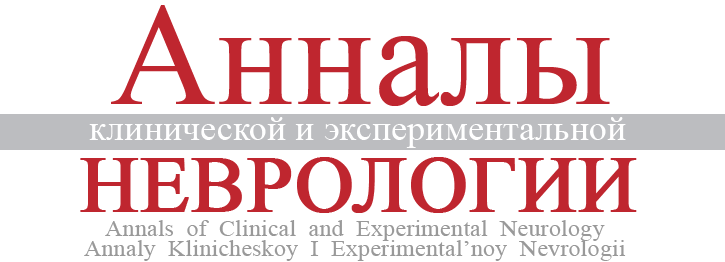Intravenous thrombolysis in acute ischemic stroke
- Authors: Domashenko M.A.1, Maksimova M.Y.1, Kistenev B.А.1, Loskutnikov M.A.1, Konovalov R.N.1, Bryukhov V.V.1, Krotenkova M.V.1, Suslina Z.A.2
-
Affiliations:
- Research Center of Neurology
- Research Centre of Neurology
- Issue: Vol 2, No 2 (2008)
- Pages: 5-12
- Section: Original articles
- Submitted: 14.02.2017
- Published: 14.02.2017
- URL: https://www.annaly-nevrologii.com/journal/pathID/article/view/452
- DOI: https://doi.org/10.17816/psaic452
- ID: 452
Cite item
Full Text
Abstract
Strategic trend in the treatment of acute stroke resulted from thrombosis or embolization of intracerebral arteries is reperfusion of the blood flow in the ischemic area – thrombolysis. The modern methods of neuroimaging (CT and MR-angiography, diffusion and perfusion-weighted MRI, CT perfusion) play an important role in the thrombolysis decision making, as they allow to visualize the occlusion of the artery causing acute stroke, recanalization of the artery due to thrombolytic therapy, as well as the dynamics of the blood flow and metabolism in the respective brain regions. The presented clinical examples demonstrate the high efficacy of the thrombolytic treatment in acute ischemic stroke under the condition of absolute compliance with the inclusion and exclusion criteria to this therapy. The treatment of patients with acute stroke should be guided by the principles of evidence-based medicine and rely on adequate diagnostic algorithm of neuroimaging methods.
Keywords
About the authors
M. A. Domashenko
Research Center of Neurology
Author for correspondence.
Email: mdomashenko@gmail.com
Russian Federation, Moscow
Marina Yu. Maksimova
Research Center of Neurology
Email: mdomashenko@gmail.com
ORCID iD: 0000-0002-7682-6672
Russian Federation, Moscow, Volokolamskoe shosse,80
B. А. Kistenev
Research Center of Neurology
Email: mdomashenko@gmail.com
Russian Federation, Moscow
M. A. Loskutnikov
Research Center of Neurology
Email: mdomashenko@gmail.com
Russian Federation, Moscow
Rodion N. Konovalov
Research Center of Neurology
Email: mdomashenko@gmail.com
ORCID iD: 0000-0001-5539-245X
Cand. Sci. (Med.), senior researcher, Neuroradiology department
Russian Federation, 125367 Moscow, Volokolamskoye shosse, 80V. V. Bryukhov
Research Center of Neurology
Email: mdomashenko@gmail.com
Russian Federation, Moscow
Marina V. Krotenkova
Research Center of Neurology
Email: mdomashenko@gmail.com
ORCID iD: 0000-0003-3820-4554
D. Sci. (Med.), Head, Radiology department
Russian Federation, 125367, Russia, Moscow, Volokolamskoye shosse, 80Z. A. Suslina
Research Centre of Neurology
Email: mdomashenko@gmail.com
Russian Federation, Moscow
References
- Суслина З.А., Танашян М.М., Ионова В.Г. Ишемический инсульт: кровь, сосудистая стенка, антитромботическая терапия. М.: Мед. книга, 2005.
- Adams H., del Zoppo G., Alberts M. et al. Guidelines for the management of adults with ischemic stroke. Stroke 2007; 38; 1655–1711.
- Barber P.A., Darby D.G., Desmond P.M. at al. Prediction of stroke outcome with echoplanar perfusion and diffusion weighted MRI. Neurology 1998; 51: 418–426.
- Clark W.M. Recombinant tissue type plasminogen activator (alteplase) for ischemic stroke 3 to 5 hours after symptom onset. The ATLANTIS Study: A randomized controlled trial. JAMA 1999; 282: 2019–2026.
- Fagan S.C., Morgenstern L.B., Petitta A. еt al. Cost effectiveness of tissue plasminogen activator for acute ischemic stroke. NINDS rttPA Stroke Study Group. Neurology 1998; 50: 883–890.
- Hacke W., Donnan G., Fieshi C. et al. Association of outcome with early stroke treatment: pooled analysis of ATLANTIS, ECASS, and NINDS rttPA stroke trials. Lancet 2004; 363: 768–774.
- Hacke W., Kaste M., Fieschi C. et al. Intravenous thrombolysis with recombinant tissue plasminogen activator for acute hemispheric stroke. The European Cooperative Acute Stroke Study (ECASS). JAMA 1995; 274: 1017–1025.
- Hacke W., Kaste M., Fieschi C. et al. Randomized double blind placebo controlled trial of thrombolytic therapy with intravenous alteplase in acute ischaemic stroke (ECASS II). Lancet 1998; 352 (9136): 1245–1251.
- Otsuka Y., Fukuyama H. CT criteria for thrombolysis in acute ischemic stroke. Nippon Rinsho 2006; 64 (Suppl. 7): 336–340.
- Schellinger P.D., Jansen O., Fiebach J.B. Monitoring intravenous recombinant tissue plasminogen activator thrombolysis for acute ischemic stroke with diffusion and perfusion MRI. Stroke 2000; 31:1318–1328.
- The National Institute of Neurological Disorders and Stroke rttPA Stroke Study Group. Tissue plasminogen activator for acute ischemic stroke. N. Engl. J. Med. 1995; 333: 1581–1587.
- Tomalla G., Sobesky J., Kohrmann M. еt al. Two tales: hemorrhagic transformation but not parenchymal hemorrhage after thrombolysis is related to severity and duration of ischemia: MRI study of acute stroke patients treated with intravenous tissue plasminogen activator within 6 hours. Stroke 2007; 38: 313–318.
- Wahlgren N., Ahmad N., Davalos A. et al. Thrombolysis with alteplase for acute ischaemic stroke in the Safe Implementation of Thrombolysis in StrokeeMonitoring Study (SISTTMOST): an observaa tional study. Lancet 2007; 369: 275–282.
- Wardlaw C., Wardlaw J. Therapeutic thrombolysis for acute ischaemic stroke. BMJ 2003; 326: 233–234.
- Wardlaw J.M., Zoppo G., Yamaguchi T. et al. Trombolysis for acute ischaemic stroke. Cochrane Database Syst. Rev. 2000; 2: CD 000213.
Supplementary files








